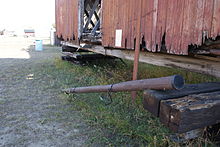Bump tree
The shock tree ( English push pole ) was predominantly in North American railroad service operation a widely used tool for maneuvering and displacement of railway carriages on a rail yard .
With a push boom it was possible to move individual cars, even if the shunting locomotive was not running on the same track as the car, but on a parallel track that ran close to it. The method had the advantage of being able to move freight wagons if other wagons were blocking access to the track. The tree was placed diagonally in special recesses, so-called poling pockets , on the coupling planks of the locomotive and wagons and was thus able to transmit the power.
A bumper tree was usually made of wood, several meters long, and strong enough not to break. The use of bumper trees was practiced until the mid-1960s. Its function was mainly replaced by drainage mountains . The New York Times reported an accident with a bump tree in 1920.
literature
- Victor von Röll (ed.): Encyclopedia of the railway system . Urban & Schwarzenberg, Berlin 1912–1923.

